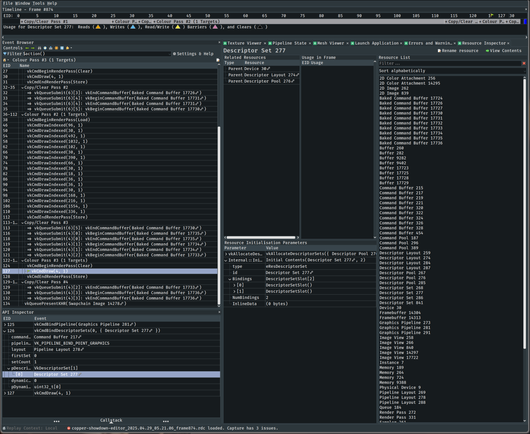Once again, #RenderDoc was completely useless.
#renderdoc
hello old friend. #renderdoc #coppershowdown
Does anyone happen to know how to get #RenderDoc to work on #Wayland? I have a very broken program I'm trying to update to newer libraries and all of the rendering code looks correct.
Made a sample #OpenXR layer for capturing graphics API calls between xrBegimFrame and xrEndFrame with #RenderDoc:
https://github.com/rAzoR8/openxr-renderdoc-layer
For #renderdoc is there no way to get its timeline to scale according to *actual time taken* rather than uniformly scaling it for every event as it does by default?
Started teaching myself #Vulkan and when they say it's verbose they weren't kidding. You gotta setup a ton of stuff just to get to basic geometry. However, I did discover #renderdoc and it's incredibly useful to see what's actually going on.
It turns out I *can* in fact brain hard enough!
Considering I started this task at 10:48 and finished around six after midnight, I'm starting to smell a pattern here. Something something best work at night?
I took screenshots of the process too in case anyone's interested.
#ProjectSpecialK #programming #cplusplus #VisualStudio2015 #opengl #glfw #optimization #renderdoc
In order to debug the vertex generation for non-full voxel path tracing I switched over to simple ray casts as the shaders compile faster, allowing me to iterate more.
Some time with Renderdoc debugging of the Vulkan compute shader has solved a few issues, and if you squint it almost looks alright.
"Why Cities: Skylines 2 performs poorly" https://blog.paavo.me/cities-skylines-2-performance/
#citiesskylines2 #rendering #renderdoc #culling #lod #performance
a very thorough and fun analysis of #citiesSkylines2 #performance
Working on packaging #renderdoc for @archlinux, and as it turns out, renderdoc does NOT like being built with LTO. Both qrenderdoc and renderdoccmd segfault immediately if built with LTO, at least on Arch.
Took me a couple hours to figure out, but now that I have, renderdoc should be landing in [extra] today.
Ah, the joys of being a graphics programmer.
I got a bug report that there are black artifiacts on every #AMD #GPU. My development machine has #NVIDIA and did not show any artifacts.
Turns out there is an asset with unspecified vertex colours. And NVIDIA defaults to white while AMD defaults to black. At least in #OpenGL. I wouldn't be so mad if this didn't take me half a day to find in #RenderDoc.
#GameDev
Vulkan/DirectX beginners please use #Renderdoc. It can give you more insight on validation errors (like what's the value of a flag that is erroneous). I just fixed a bug for a fiverr client that was caused by a small code mistake but so hard to find without renderdoc's insight.
Nevermind, don't use renderdoc, I need fiverr money :^)
OK #RenderDoc is incredible.
Assuming you managed to dive through the insanity of the glslang API¹, you can actually debug a single fragment shader from their #GLSL form.
Being able to observe the exact values of everything is absolute bliss.
The debugger is basic but there is one incredible option: "Run forwards to NaN/Inf". This is going to be particularly useful to me and my gigantic shader full of nested loops.
Note: this is not possible with OpenGL.
I've been skeptic about #RenderDoc but the more I dig into it, the more I like it. Today while trying to make the shader debugger working, I found the shader editor (useful for live change debugging), and also the way to add a custom view on a texture by writing a custom shader snippet.
Typical use case, here I have a signed distance texture, and I'm using a custom #glsl fragment (the sdf debug color scheme from Inigo Quilez) to display it. I love this.
Got it working with UE5 on the weekend, so I can import a Renderdoc capture, extract the dispatches and debug it. Still pretty rough, but stepping through the UE5 Hi-Z build shader is awesome. Oh and the D3D12 capture is running in my Vulkan renderer! #UE5 #renderdoc

